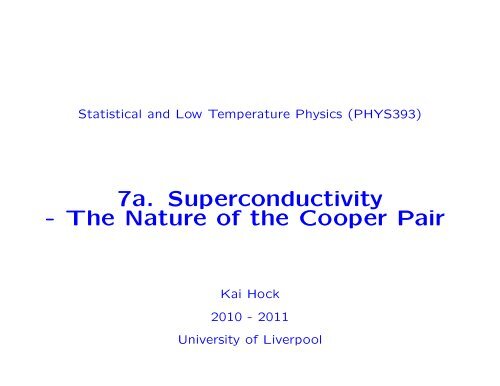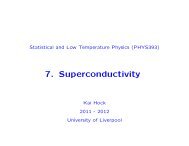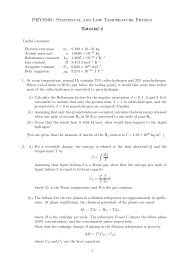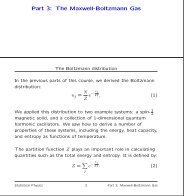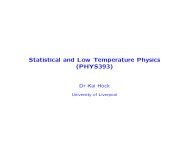The Nature of the Cooper Pair - University of Liverpool
The Nature of the Cooper Pair - University of Liverpool
The Nature of the Cooper Pair - University of Liverpool
Create successful ePaper yourself
Turn your PDF publications into a flip-book with our unique Google optimized e-Paper software.
Statistical and Low Temperature Physics (PHYS393)<br />
7a. Superconductivity<br />
- <strong>The</strong> <strong>Nature</strong> <strong>of</strong> <strong>the</strong> <strong>Cooper</strong> <strong>Pair</strong><br />
Kai Hock<br />
2010 - 2011<br />
<strong>University</strong> <strong>of</strong> <strong>Liverpool</strong>
To develop <strong>the</strong> idea ...<br />
1. Estimate <strong>the</strong> attraction between two electrons.<br />
2. Guess a wavefunction for <strong>the</strong> electron pair.<br />
3. Solve Schrodinger’s equation for <strong>the</strong> energy.<br />
4. Obtain <strong>the</strong> wavefunction <strong>of</strong> <strong>the</strong> <strong>Cooper</strong> pair.<br />
5. Explain why a superconductor has zero resistance.<br />
(Weisskopf(1979)http://cdsweb.cern.ch/record/880131/files/p1.pdf)<br />
Superconductivity 1
When an electron passes in between two positive ions in a<br />
metal, it attracts <strong>the</strong> ions.<br />
<strong>The</strong> ions move closer toge<strong>the</strong>r, creating a region that has<br />
slightly higher positive charge. This creates an attractive<br />
potential for o<strong>the</strong>r electrons.<br />
Superconductivity 2
<strong>The</strong> potential energy <strong>of</strong> an electron due to a positive ion is<br />
U = − e2<br />
4πɛ0r .<br />
This is normally cancelled out by <strong>the</strong> free electrons. If an ion is<br />
displaced, <strong>the</strong> change in <strong>the</strong> potential is <strong>the</strong> attractive potential<br />
that now appears. This may be estimated by <strong>the</strong> small change<br />
approximation:<br />
δU ≈ dU<br />
dr δr.<br />
Superconductivity 3
Using <strong>the</strong> small change approximation, <strong>the</strong> attractive potential<br />
is<br />
V ≈ − e2<br />
4πɛ0d 2δ<br />
where r is roughly <strong>the</strong> distance d between ions, and δ is <strong>the</strong><br />
displacement <strong>of</strong> <strong>the</strong> ion.<br />
To estimate δ, consider <strong>the</strong> ion next <strong>the</strong> electron path.<br />
Superconductivity 4
<strong>The</strong> force from this electron is likely to be active over a<br />
distance d near <strong>the</strong> ion. At larger distance, it tends to get<br />
screened <strong>of</strong>f by a rearrangement <strong>of</strong> <strong>the</strong> o<strong>the</strong>r electrons.<br />
Assuming that <strong>the</strong> electron is roughly at <strong>the</strong> Fermi energy, its<br />
velocity ve is related to <strong>the</strong> Fermi energy E F by:<br />
EF = 1<br />
2 mev 2 e .<br />
<strong>The</strong> attraction is active for a time<br />
τ = d<br />
.<br />
Superconductivity 5<br />
ve
<strong>The</strong> attractive force is <strong>the</strong> Coulomb force<br />
F = − e2<br />
4πɛ0r 2<br />
where r is roughly <strong>the</strong> distance d between between ions.<br />
So <strong>the</strong> impulse <strong>of</strong> <strong>the</strong> passing electron in <strong>the</strong> ion is<br />
F τ = − e2<br />
4πɛ0d 2<br />
This is like a kick on <strong>the</strong> ion. For small displacements, <strong>the</strong><br />
motion <strong>of</strong> <strong>the</strong> ion is approximately simple harmonic.<br />
Superconductivity 6<br />
d<br />
ve<br />
.
In a simple harmonic motion with amplitude A and frequency ω,<br />
<strong>the</strong> maximum velocity at <strong>the</strong> rest position is<br />
v0 = Aω.<br />
This maximum frequency would <strong>the</strong> velocity <strong>of</strong> <strong>the</strong> ion as it<br />
takes <strong>of</strong>f immediately after <strong>the</strong> kick, so<br />
v0 =<br />
where M is <strong>the</strong> mass <strong>of</strong> <strong>the</strong> ion.<br />
<strong>The</strong> amplitude A corresponds to <strong>the</strong> displacement δ that we<br />
want to find. <strong>The</strong> frequency ω would be <strong>the</strong> Debye frequency.<br />
Superconductivity 7<br />
F τ<br />
M
Recall that <strong>the</strong> Debye frequency ω D is <strong>the</strong> maximum vibrational<br />
frequency in a lattice. This happens when <strong>the</strong> ion spacing is<br />
equal to a half wavelength:<br />
Compare this with <strong>the</strong> picture <strong>of</strong> <strong>the</strong> ions attracted by a<br />
passing electron:<br />
In both cases, <strong>the</strong> electron cloud in between would be deformed<br />
in <strong>the</strong> same way. We can expect <strong>the</strong> same restoring forces on<br />
<strong>the</strong> ions, and <strong>the</strong>refore <strong>the</strong> same frequency.<br />
Superconductivity 8
Combining <strong>the</strong>se ideas,<br />
v0 = Aω<br />
gives<br />
F τ<br />
M = δωD. <strong>The</strong>refore <strong>the</strong> displacement is<br />
δ =<br />
F τ<br />
Mω D<br />
=<br />
e2<br />
4πɛ0d 2<br />
d<br />
1<br />
ve MωD Recall <strong>the</strong> formula for <strong>the</strong> Debye frequency:<br />
ω D =<br />
� �<br />
6Nπ2v 3 1/3<br />
where v is <strong>the</strong> speed <strong>of</strong> sound in <strong>the</strong> metal.<br />
We can thus estimate <strong>the</strong> displacement δ.<br />
Superconductivity 9<br />
V<br />
,<br />
.
<strong>The</strong> displacement <strong>the</strong>n gives us <strong>the</strong> attractive potential energy:<br />
V ≈ − e2<br />
4πɛ0d 2δ.<br />
However, <strong>the</strong> ion will return to <strong>the</strong> rest position after a time.<br />
This time is half <strong>of</strong> <strong>the</strong> period <strong>of</strong> <strong>the</strong> simple harmonic motion,<br />
<strong>the</strong> period being<br />
T = 2π<br />
.<br />
ωD During <strong>the</strong> time T/2, <strong>the</strong> electron travels a distance<br />
l = veT<br />
2<br />
Superconductivity 10<br />
πve<br />
= .<br />
ωD
<strong>The</strong> electron would <strong>the</strong>refore leave a trail <strong>of</strong> deflected ions<br />
behind it. This trail that extends for a distance l, and only<br />
exists along a narrow tube in between ions.<br />
This net positive charge can attraction ano<strong>the</strong>r electron that<br />
happens to be travelling in <strong>the</strong> opposite direction through this<br />
same tube.<br />
So <strong>the</strong>re is an attractive potential between two such electrons<br />
that extends over <strong>the</strong> distance l.<br />
Superconductivity 11
We shall approximately represent <strong>the</strong> attractive potential as a<br />
function that is constant within <strong>the</strong> range l:<br />
where<br />
V (r) =<br />
�<br />
V0 =<br />
−V0 for r < l<br />
0 for r > l<br />
e2<br />
4πɛ0d 2δ.<br />
We have seen that <strong>the</strong> potential only exists within a narrow<br />
tube, so it is not exactly a spherical potential.<br />
However, if two electrons happen to be travelling in opposite<br />
directions and pass very close to each o<strong>the</strong>r, <strong>the</strong>n <strong>the</strong> potential<br />
has <strong>the</strong> same effect as a spherical potential, because <strong>the</strong><br />
electrons do not experience <strong>the</strong> potential outside <strong>of</strong> <strong>the</strong> tube.<br />
Superconductivity 12
We now want to find out if two electrons can attract in <strong>the</strong><br />
way just described, and form a bound state - a <strong>Cooper</strong> pair.<br />
A bound state refers to a wavefunction that has a finite size,<br />
like <strong>the</strong> wavefunction <strong>of</strong> an electron in an atom. This means<br />
that <strong>the</strong> value <strong>of</strong> <strong>the</strong> wavefunction falls <strong>of</strong>f to zero after some<br />
distance.<br />
In contrast, a free electron is not in a bound state. Its<br />
wavefunction may be e ikx , which has <strong>the</strong> same amplitude at<br />
any distance.<br />
Since we treat <strong>the</strong> potential as effectively spherical, we can use<br />
<strong>the</strong> same form <strong>of</strong> <strong>the</strong> Schrodinger equation as for <strong>the</strong> hydrogen<br />
atom.<br />
Superconductivity 13
We have seen that two electrons must travel in opposite<br />
directions, and <strong>the</strong> paths must be very close, before <strong>the</strong>y can<br />
experience <strong>the</strong> attractive potential.<br />
Electrons are at <strong>the</strong> Fermi energy have a wavelength <strong>of</strong> <strong>the</strong><br />
order <strong>of</strong> d, <strong>the</strong> spacing between ions. We can see this by<br />
comparing <strong>the</strong> kinetic energy with E F :<br />
� 2 k 2 F<br />
2me<br />
= �2<br />
2me<br />
� �<br />
3π2 2/3<br />
N<br />
k F is <strong>the</strong> wavevector at 2π/λ F <strong>the</strong> Fermi energy, where λ F is <strong>the</strong><br />
wavelength.<br />
Superconductivity 14<br />
V<br />
.
V/N would be <strong>the</strong> volume associated with one electron, or ion,<br />
and this is <strong>of</strong> <strong>the</strong> order d 3 . Substituting <strong>the</strong>se, we find<br />
� 2π<br />
λ F<br />
� 2<br />
=<br />
Solving for <strong>the</strong> wavelength gives<br />
� �<br />
3π2 2/3<br />
d 3<br />
λ F ≈ 2d.<br />
Since <strong>the</strong> distance between <strong>the</strong> paths <strong>of</strong> <strong>the</strong> two electrons is<br />
smaller than λ F , because both must be roughly in between <strong>the</strong><br />
same pair <strong>of</strong> ions, we may assume that <strong>the</strong> angular momentum<br />
is zero.<br />
To see this, ...<br />
Superconductivity 15<br />
.
... recall <strong>the</strong> quantisation condition for <strong>the</strong> angular momentum<br />
in <strong>the</strong> Bohr atom:<br />
<strong>The</strong> angular momentum is quantised according to <strong>the</strong> number<br />
<strong>of</strong> wavelengths in <strong>the</strong> orbit. If <strong>the</strong> orbit is smaller than one<br />
wavelength, <strong>the</strong>n <strong>the</strong>re is zero wavelength, and <strong>the</strong> angular<br />
momentum must be zero.<br />
Superconductivity 16
So if <strong>the</strong> distance between <strong>the</strong> electrons is smaller than <strong>the</strong><br />
wavelength <strong>of</strong> each electron, <strong>the</strong>n <strong>the</strong> angular momentum<br />
would be zero. In a simplistic way, we may imagine <strong>the</strong> <strong>the</strong><br />
electron pair move against each o<strong>the</strong>r along very close, parallel<br />
paths, and that <strong>the</strong>y equally likely to do so in any direction.<br />
That is, <strong>the</strong> wavefunction should be spherically symmetric.<br />
Superconductivity 17
<strong>The</strong> Schrodinger equation is <strong>the</strong>n <strong>of</strong> <strong>the</strong> same form as that for<br />
<strong>the</strong> <strong>the</strong> ground state electron <strong>of</strong> <strong>the</strong> hydrogen atom:<br />
− �2 1<br />
2µ r2 d<br />
R dr<br />
�<br />
r 2dR<br />
dr<br />
�<br />
+ V (r)R = ER.<br />
except that <strong>the</strong> electron mass is replaced by µ, <strong>the</strong> reduced<br />
mass me/2. We need to use this reduced mass because both<br />
electrons are moving, unlike a hydrogen atom in which <strong>the</strong><br />
nucleus is approximately stationary.<br />
http://en.wikipedia.org/wiki/Reduced_mass<br />
To show that a bound state is possible, we need to solve this<br />
equation to see if <strong>the</strong> wavefunction has a finite size.<br />
Superconductivity 18
If V (r) is constant, <strong>the</strong> solution is <strong>of</strong> <strong>the</strong> form<br />
ψ(r) = sin(kr).<br />
However, V (r) is not constant. It becomes zero beyond r = l.<br />
We can try a sum <strong>of</strong> sine functions:<br />
Ψ(r) = �<br />
ak sin(kr),<br />
where a k are unknown constants that we must find.<br />
k<br />
We now come <strong>the</strong> <strong>the</strong> important part. <strong>The</strong> need for this sum<br />
means that energy states with many wavevectors k must be<br />
used to make up <strong>the</strong> wavefunction. However, we are not<br />
allowed to use k values below <strong>the</strong> Fermi energy, because those<br />
states are fully occupied.<br />
<strong>The</strong>refore, we must impose <strong>the</strong> condition that k must be more<br />
than k F , <strong>the</strong> wavevector at <strong>the</strong> Fermi energy.<br />
<strong>The</strong> detailed steps to solve <strong>the</strong> Schrodinger equation are given<br />
in <strong>the</strong> appendix.<br />
Superconductivity 19
Here, we just state <strong>the</strong> solution to <strong>the</strong> Schrodinger equation.<br />
<strong>The</strong> wavefunction is<br />
Ψ =<br />
�ω<br />
�D<br />
0<br />
aε sin kr =<br />
�ω<br />
�D<br />
0<br />
1<br />
ε + ∆<br />
sin kr<br />
where k is in steps <strong>of</strong> π/R, R being roughly <strong>the</strong> radius <strong>of</strong> a<br />
sphere similar in size to <strong>the</strong> metal. (R corresponds to <strong>the</strong> length<br />
L <strong>of</strong> <strong>the</strong> cube that is commonly used for electrons in metal.)<br />
ε is <strong>the</strong> energy above <strong>the</strong> Fermi energy. k is related to ε by<br />
− EF .<br />
2me<br />
<strong>The</strong> energy <strong>of</strong> <strong>the</strong> electron pair is<br />
ε = �2 k 2<br />
E = E F − ∆.<br />
∆ is called <strong>the</strong> binding energy, and is given by<br />
∆ = �ωD exp(− 2πkF ).<br />
melV0<br />
Superconductivity 20
Let us see what <strong>the</strong> wavefunction looks like.<br />
Ψ =<br />
�ω<br />
�D<br />
0<br />
1<br />
ε + ∆<br />
sin kr<br />
It is a function <strong>of</strong> r only, so it is spherically symmetric. It is a<br />
sum <strong>of</strong> many sine functions. <strong>The</strong> coefficient decreases with<br />
energy. When <strong>the</strong> energy ε goes from 0 to ∆, <strong>the</strong> coefficient<br />
decreases from 1/∆ to 1/(2∆).<br />
So we may suppose that <strong>the</strong> terms are only significant in <strong>the</strong><br />
energy range from 0 to ∆. As energy changes, k changes.<br />
When r is large enough, sin kr starts to go out <strong>of</strong> phase for<br />
different wavevectors k.<br />
Superconductivity 21
<strong>The</strong>y will start interfering destructively, and <strong>the</strong> sum Ψ will<br />
decrease. This gives us a way <strong>of</strong> estimating <strong>the</strong> size <strong>of</strong> <strong>the</strong><br />
wavefunction.<br />
Consider <strong>the</strong> minimum and maximum k. <strong>The</strong>se correspond to<br />
<strong>the</strong> energies ε = 0 and 1/∆, relative to E F . <strong>The</strong> absolute<br />
energies are E F and E F + ∆.<br />
Consider <strong>the</strong> radius r = ρ at which <strong>the</strong> sine functions for <strong>the</strong>se<br />
two values <strong>of</strong> k first get out <strong>of</strong> phase by π radians. This gives<br />
<strong>the</strong> largest cancellation, and we may take this radius ρ as an<br />
estimate <strong>of</strong> <strong>the</strong> size <strong>of</strong> <strong>the</strong> wavefunction.<br />
Superconductivity 22
Let <strong>the</strong> difference in k be ∆k. <strong>The</strong> phase at ρ for each sine<br />
function is kρ. Since this difference is is π between <strong>the</strong><br />
maximum and minimum k, so<br />
∆k.ρ = π.<br />
To express in terms <strong>of</strong> E F , we use<br />
E = p2<br />
.<br />
2me<br />
<strong>The</strong> small change approximation gives<br />
∆E = p∆p<br />
.<br />
me<br />
At <strong>the</strong> Fermi energy, and for an energy change ∆E equal to ∆,<br />
we have<br />
∆ = p F ∆p<br />
me<br />
Superconductivity 23<br />
= pF .�∆k<br />
.<br />
me
Using<br />
∆k.ρ = π<br />
we can solve for <strong>the</strong> size <strong>of</strong> <strong>the</strong> wavefunction:<br />
ρ = hp F<br />
2me∆ .<br />
Putting in typical values, we find <strong>the</strong> <strong>the</strong> size <strong>of</strong> <strong>the</strong><br />
wavefunction is <strong>of</strong> <strong>the</strong> order <strong>of</strong> 10 −4 cm. This is much larger<br />
than <strong>the</strong> size <strong>of</strong> an atom.<br />
Superconductivity 24
So we have found a bound pair - a wavefunction <strong>of</strong> two<br />
electrons that has a finite size. This is in spite <strong>of</strong> <strong>the</strong> fact that<br />
<strong>the</strong> kinetic energies <strong>of</strong> <strong>the</strong> electrons, which are close to E F , are<br />
much larger than <strong>the</strong> binding energy ∆.<br />
Ma<strong>the</strong>matically, we have seen that this solution is obtained<br />
after we impose <strong>the</strong> condition that <strong>the</strong> wavefunction sum<br />
Ψ = � α k sin kr<br />
must not contain any wavevector below that Fermi level.<br />
We can interpret this physically. If <strong>the</strong> bound pair <strong>of</strong> electrons<br />
separate, <strong>the</strong>y become plane waves and would have to occupy<br />
two <strong>of</strong> <strong>the</strong> energy states below E F . However, we are talking<br />
about 0 K, and all states below E F are fully. <strong>The</strong>re is no room<br />
for any more electron, because <strong>of</strong> <strong>the</strong> exclusion principle. That<br />
is why <strong>the</strong> pair must, with an energy just below E F (by ∆),<br />
must remain bound.<br />
Superconductivity 25
<strong>The</strong> bound pair <strong>of</strong> electrons is <strong>the</strong> <strong>Cooper</strong> pair. <strong>The</strong>y would<br />
have opposite spins, so <strong>the</strong> resultant spin is zero. <strong>The</strong> <strong>Cooper</strong><br />
pair is a boson.<br />
Because <strong>the</strong> pair <strong>of</strong> electrons have opposite momenta, <strong>the</strong><br />
resultant momentum is also zero. If many <strong>Cooper</strong> pairs are<br />
formed, <strong>the</strong>y would all occupy <strong>the</strong> same state - <strong>of</strong> zero<br />
momentum. This is now possible because <strong>the</strong> pairs are bosons.<br />
<strong>The</strong> result is a condensate that is very similar to <strong>the</strong><br />
Bose-Einstein condensate.<br />
Exactly how many <strong>Cooper</strong> pairs are formed?<br />
In order to esimate <strong>the</strong> number, assume that all <strong>Cooper</strong> pairs<br />
have <strong>the</strong> same wavefunction:<br />
Ψ =<br />
ε�<br />
0<br />
1<br />
ε + ∆<br />
sin kr,<br />
that is, <strong>the</strong> component wavevectors k cannot be below <strong>the</strong><br />
Fermi level. We shall justify <strong>the</strong> assumption afterwards.<br />
Superconductivity 26
<strong>The</strong>n suppose that two electrons at <strong>the</strong> Fermi level E F start<br />
pairing up. When <strong>the</strong>y pair up, <strong>the</strong>ir energy falls by ∆, to<br />
2E F − ∆.<br />
Next, imagine that more electrons pair up. As more and more<br />
electrons pair up, <strong>the</strong> Fermi sea gets depleted, and <strong>the</strong> ”sea”<br />
level falls. (This is not to be confused with <strong>the</strong> Fermi energy,<br />
which is still defined as E F .) <strong>The</strong> electron pair would always<br />
have <strong>the</strong> same energy <strong>of</strong> 2E F − ∆, because <strong>the</strong>y have <strong>the</strong> same<br />
wavefunction Ψ.<br />
This goes on until <strong>the</strong> sea level has fallen by ∆/2, to<br />
E F − ∆/2. A pair <strong>of</strong> electrons at this level would have already<br />
have a total energy <strong>of</strong> 2E F − ∆. <strong>The</strong>re is no advantage <strong>of</strong><br />
forming a bound pair, which also have <strong>the</strong> same energy. So <strong>the</strong><br />
electrons stop pairing up.<br />
Superconductivity 27
<strong>The</strong> number <strong>of</strong> <strong>Cooper</strong> pairs is <strong>the</strong>refore equal to half <strong>of</strong> <strong>the</strong><br />
number <strong>of</strong> electrons with ∆/2 <strong>of</strong> <strong>the</strong> Fermi energy. This is<br />
given by 1 2 × 2g(E F )∆/2.<br />
Recall from <strong>the</strong> notes on electrons in metal that<br />
g(EF ) = 3N<br />
.<br />
4EF So <strong>the</strong> number <strong>of</strong> <strong>Cooper</strong> pairs is<br />
N ′ = g(E F ) ∆<br />
2<br />
3N∆<br />
= .<br />
8EF We can estimate <strong>the</strong> distance between <strong>Cooper</strong> pairs by dividing<br />
<strong>the</strong> volume <strong>of</strong> <strong>the</strong> metal V by N ′ to get <strong>the</strong> volume occupied by<br />
one <strong>Cooper</strong> pair. Taking this to be a cube, <strong>the</strong> side <strong>of</strong> <strong>the</strong> cube<br />
would give an estimate <strong>of</strong> <strong>the</strong> distance D between adjacent<br />
pairs:<br />
D =<br />
Superconductivity 28<br />
�<br />
V<br />
N ′<br />
�1/3
Putting in <strong>the</strong> numbers, we would find that <strong>the</strong> distance D<br />
between <strong>the</strong> <strong>Cooper</strong> pairs is about 30d, where d is <strong>the</strong> distance<br />
between <strong>the</strong> ions.<br />
Since <strong>the</strong> size <strong>of</strong> <strong>the</strong> <strong>Cooper</strong> pair wavefunction is around 10 −4<br />
cm, this means that <strong>the</strong>re is a lot <strong>of</strong> overlap between <strong>Cooper</strong><br />
pairs. However, <strong>the</strong>re must be a distance below which two<br />
<strong>Cooper</strong> pair wavefunctions cannot come any closer, just as <strong>the</strong><br />
wavefunctions between two atoms must start repelling if <strong>the</strong>y<br />
come too close.<br />
According to Victor Weisskopf, <strong>the</strong> average distance D between<br />
<strong>Cooper</strong> pairs is just this distance. This means that <strong>the</strong> <strong>Cooper</strong><br />
pairs are packed in a compact way, just like liquid helium-4. It<br />
behaves like a liquid instead <strong>of</strong> a gas.<br />
(Weisskopf(1979)http://cdsweb.cern.ch/record/880131/files/p1.pdf)<br />
Superconductivity 29
So, as in superfluid helium-4, we may expect phonons and<br />
rotons, and that <strong>the</strong> critical velocity be determined by <strong>the</strong><br />
minimum roton excitation.<br />
If we think <strong>of</strong> <strong>the</strong> rotation as a rotation <strong>of</strong> two <strong>Cooper</strong> pairs<br />
about each o<strong>the</strong>r, we can relate <strong>the</strong> roton excitation to <strong>the</strong><br />
minimum rotational energy. <strong>The</strong> rotational energy is quantised<br />
and <strong>the</strong> minimum is given by 2� 2 /meD 2 .<br />
If we put in <strong>the</strong> numbers, we would find that this is much larger<br />
than ∆, <strong>the</strong> binding energy for <strong>the</strong> <strong>Cooper</strong> pair. <strong>The</strong> <strong>Cooper</strong><br />
pair would break before any roton gets excited.<br />
As long as <strong>the</strong>re is not enough energy to break <strong>the</strong> <strong>Cooper</strong><br />
pairs, <strong>the</strong> <strong>Cooper</strong> pair condensate flows with zero resistance.<br />
This condesate is also called <strong>the</strong> BCS superfluid. This explains<br />
why a superconductor has zero resistance.<br />
Superconductivity 30
At temperature T , we would expect <strong>the</strong>rmal energies <strong>of</strong> <strong>the</strong><br />
order <strong>of</strong> k BT , ei<strong>the</strong>r in <strong>the</strong> form <strong>of</strong> phonons or excited<br />
electrons. If this energy is more than ∆, <strong>the</strong>n <strong>the</strong>re is enough<br />
energy to break <strong>the</strong> <strong>Cooper</strong> pairs. If this happens, <strong>the</strong> metal<br />
returns to being normal conducting, with resistance.<br />
<strong>The</strong> transition temperature Tc is <strong>the</strong>refore related to <strong>the</strong><br />
binding energy by<br />
k BTc ≈ ∆.<br />
<strong>The</strong> complete BCS <strong>the</strong>ory gives <strong>the</strong> more accurate relation <strong>of</strong><br />
1.76k BTc = ∆<br />
which agrees well with measured values <strong>of</strong> Tc and ∆.<br />
Superconductivity 31
APPENDIX: Solving for <strong>the</strong> <strong>Cooper</strong> pair wavefunction<br />
Superconductivity 32
<strong>The</strong> Schrodinger equation has <strong>the</strong> same form as that for <strong>the</strong><br />
ground state electron <strong>of</strong> <strong>the</strong> hydrogen atom:<br />
− �2 1<br />
2µ r2 d<br />
R dr<br />
�<br />
r 2dR<br />
dr<br />
�<br />
+ V (r)R = ER.<br />
except that <strong>the</strong> electron mass is replaced by µ, <strong>the</strong> reduced<br />
mass me/2.<br />
<strong>The</strong> Schrodinger equation can be rewritten in <strong>the</strong> familiar 1D<br />
form by using a new function<br />
ψ(r) = rR(r).<br />
Note this this is r times <strong>the</strong> actual wavefunction R(r). <strong>The</strong><br />
Schrodinger equation <strong>the</strong>n becomes<br />
− �2<br />
2µ<br />
Superconductivity 33<br />
d2ψ + V (r)ψ = Eψ.<br />
dr2
<strong>The</strong> attractive potential is very small. It is known in quantum<br />
mechanics that a bound state is not possible if this is so.<br />
http://en.wikipedia.org/wiki/Finite_potential_well<br />
However, <strong>the</strong> electrons here are not in free space. Those at <strong>the</strong><br />
Fermi energy are not allowed to have smaller energies, because<br />
all <strong>the</strong> states are occupied.<br />
In <strong>the</strong> 1950s, Leon <strong>Cooper</strong> showed that when this happens, a<br />
bound state becomes possible.<br />
Superconductivity 34
To show that a bound state exists, we need to solve <strong>the</strong><br />
Schrodinger’s equation. If V (r) is constant, <strong>the</strong> solution is<br />
ψ(r) = sin(kr).<br />
However, V (r) is not constant. We may still try a solution in<br />
<strong>the</strong> form <strong>of</strong> a sum <strong>of</strong> sine functions:<br />
Ψ(r) = �<br />
ak sin(kr),<br />
where a k are unknown constants that we must find.<br />
k<br />
When we study electrons in metal, we learn how k is quantised<br />
by solving Schrodinger’s equation for a cube. Since we now<br />
have spherical symmetry, we shall use a sphere <strong>of</strong> radius R<br />
instead (not to be confused with <strong>the</strong> wavefunction R(r)).<br />
Superconductivity 35
<strong>The</strong>refore<br />
and<br />
sin(kR) = 0,<br />
k = nπ<br />
R .<br />
We shall need to make use <strong>of</strong> this later.<br />
Rearrange <strong>the</strong> Schrodinger’s equation:<br />
Substitute<br />
and get<br />
�<br />
k ′<br />
�<br />
�2k ′2<br />
ak ′<br />
me<br />
− �2<br />
me<br />
d2Ψ − EΨ = −V (r)Ψ.<br />
dr2 Ψ(r) = �<br />
ak ′ sin(k ′ r)<br />
− E<br />
Superconductivity 36<br />
�<br />
k ′<br />
sin(k ′ r) = −V (r) �<br />
ak ′ sin(k ′ r).<br />
k ′
We apply <strong>the</strong> relation<br />
Multiply<br />
� R<br />
0 sin(kr) sin(k′ r)dr =<br />
�<br />
k ′<br />
�<br />
�2k ′2<br />
ak ′<br />
me<br />
− E<br />
by sin(kr) and integrate, we get<br />
where<br />
R<br />
2 a k<br />
�<br />
� � 2 k 2<br />
me<br />
�<br />
R/2 for k = k ′<br />
0 o<strong>the</strong>rwise<br />
sin(k ′ r) = −V (r) �<br />
ak ′ sin(k ′ r)<br />
− E<br />
� l<br />
�<br />
k ′<br />
= − �<br />
ak ′Vkk ′,<br />
Vkk ′ = V0<br />
0 sin(kr) sin(k′ r)dr.<br />
<strong>The</strong> upper limit is l instead <strong>of</strong> R because V (r) is zero for r > l.<br />
Superconductivity 37<br />
k ′
<strong>The</strong> product <strong>of</strong> <strong>the</strong> waves sin(kr) and sin(k ′ r) would be<br />
oscillatory.<br />
If k and k ′ are not equal, <strong>the</strong>n it oscillates between plus and<br />
minus, and <strong>the</strong> integral may cancel to zero.<br />
If k and k ′ are nearly equal, <strong>the</strong>n <strong>the</strong> product is nearly always<br />
positive.<br />
This is likely to happen if, within <strong>the</strong> distance l, <strong>the</strong> two waves<br />
differ by less than half wavelength. This means<br />
or<br />
kl − k ′ l = π,<br />
k − k ′ = π/l.<br />
Superconductivity 38
Recall that<br />
So<br />
Returning to<br />
V kk ′ = V0<br />
l = πve/ω D.<br />
k − k ′ = ω D/ve.<br />
� l<br />
0 sin(kr) sin(k′ r)dr,<br />
we can say that if k − k ′ is more than ω D/ve, <strong>the</strong> integral is<br />
approximately zero.<br />
If not, we may roughly take it to be <strong>the</strong> value when k = k ′ ,<br />
which is l/2. <strong>The</strong>refore<br />
V kk ′ =<br />
Superconductivity 39<br />
�<br />
lV0/2 for k − k ′ < ω D/ve<br />
0 for k − k ′ > ω D/ve
Return to <strong>the</strong> Schrodinger’s equation<br />
R<br />
2 a k<br />
� � 2 k 2<br />
me<br />
− E<br />
�<br />
= − �<br />
ak ′Vkk ′.<br />
We shall now change from k to energy variable. For reasons<br />
that will become clear, we define <strong>the</strong> variable ε to be <strong>the</strong><br />
energy above E F . So<br />
ε = �2 k 2<br />
me<br />
k ′<br />
− E F .<br />
We define <strong>the</strong> amount <strong>of</strong> energy that E is below <strong>the</strong> Fermi<br />
energy by<br />
<strong>The</strong> equation is now<br />
∆ = E F − E.<br />
R<br />
2 ak(ε + ∆) = − �<br />
Superconductivity 40<br />
k ′<br />
a k ′V kk ′.
Next, we approximate � a k ′V kk ′ to an integral. To do this, we<br />
need <strong>the</strong> density <strong>of</strong> states. We know that<br />
k = nπ/R.<br />
So <strong>the</strong>re is one state for every interval <strong>of</strong> π/R in k, or <strong>the</strong><br />
density <strong>of</strong> state is<br />
g(k) = R/π.<br />
We now come to an important point. We are going to impose<br />
<strong>the</strong> condition that k must be above <strong>the</strong> Fermi level. We shall<br />
intepret this condition after we have found <strong>the</strong> bound state.<br />
Recall<br />
ε = �2 k 2<br />
me<br />
Superconductivity 41<br />
− E F .
So in energy variable, <strong>the</strong> density <strong>of</strong> states is<br />
g(ε) = g(k) dk<br />
dε<br />
At <strong>the</strong> Fermi energy,<br />
= R<br />
π .me<br />
2k .<br />
g(0) = meR<br />
.<br />
2πkF Note that we are taking <strong>the</strong> Fermi energy at <strong>the</strong> origin, so zero<br />
energy here means Fermi energy. Combining <strong>the</strong>se ideas, we<br />
obtain<br />
�<br />
k ′<br />
a k ′V kk ′ ≈<br />
�<br />
a ε ′V εε ′g(0)dε ′<br />
<strong>The</strong> lower limit <strong>of</strong> <strong>the</strong> integral is 0, <strong>the</strong> Fermi level. To find <strong>the</strong><br />
upper limit, we recall that V kk ′ is zero if k − k ′ > ω D/ve.<br />
Superconductivity 42
To change to energy variable, rewrite as δk > ω D/ve. Using<br />
we find<br />
δε = 2�2 kδk<br />
me<br />
ε = �2 k 2<br />
me<br />
− E F ,<br />
= 2�pδk<br />
me<br />
Multiplying δk > ω D/ve by �2ve, we obtain<br />
δε > 2�ω D.<br />
So if ε − ε ′ is more than 2�ω D, V εε ′ is zero.<br />
<strong>The</strong> Schrodinger equations is<br />
= 2�veδk.<br />
R<br />
2 aε(ε + ∆) = −g(0) aε ′Vεε ′dε ′ .<br />
If ε is zero, Vεε ′ goes to zero when ε ′ > 2�ωD. So we may take<br />
<strong>the</strong> upper limit to be 2�ωD. Superconductivity 43<br />
�
However, ε is 2�ω D, <strong>the</strong>n <strong>the</strong> upper limit must be even higher.<br />
We assume that aε is significantly different from zero only for<br />
ε
<strong>The</strong> right hand side <strong>of</strong> <strong>the</strong> Schrodinger equation<br />
aε(ε + ∆) = −B<br />
is a constant. Let this be C. So<br />
or<br />
� �ωD<br />
0<br />
aε(ε + ∆) = C,<br />
aε = C<br />
ε + ∆ .<br />
a ε ′dε ′ .<br />
Substituting this back into <strong>the</strong> Schrodinger equation, we get<br />
Integrating, we find<br />
1 = −B<br />
� �ωD<br />
0<br />
dε ′<br />
ε ′ + ∆ .<br />
∆ = �ωD exp(−1/B) = �ωD exp(− 2πkF ).<br />
melV0<br />
Superconductivity 45
We have found both aε and ∆. This means that we have found<br />
both <strong>the</strong> wavefunction Ψ and <strong>the</strong> energy E.<br />
In o<strong>the</strong>r words, we have solved <strong>the</strong> Schrodinger equation!<br />
<strong>The</strong> wavefunction is<br />
Ψ =<br />
�ω<br />
�D<br />
where k is related to ε by<br />
<strong>The</strong> energy is<br />
0<br />
aε sin kr =<br />
ε = �2 k 2<br />
2me<br />
�ω<br />
�D<br />
0<br />
− E F .<br />
1<br />
ε + ∆<br />
sin kr<br />
E = EF − ∆ = E − �ωD exp(− 2πkF ).<br />
melV0<br />
Superconductivity 46
Putting in <strong>the</strong> numbers, we find that ∆ is about 10 −4 smaller<br />
than <strong>the</strong> Fermi energy.<br />
Compared to �ω D, ∆ is about 10 −2 smaller. Since<br />
we have<br />
and<br />
So<br />
a �ωD =<br />
aε = C<br />
ε + ∆ ,<br />
a0 = C<br />
∆<br />
C<br />
�ω D + ∆ ≈<br />
a �ωD ≈ 10 −2 a0.<br />
C<br />
100∆ + ∆ .<br />
This justifies our assumption that aε is significantly different<br />
from zero only for ε


